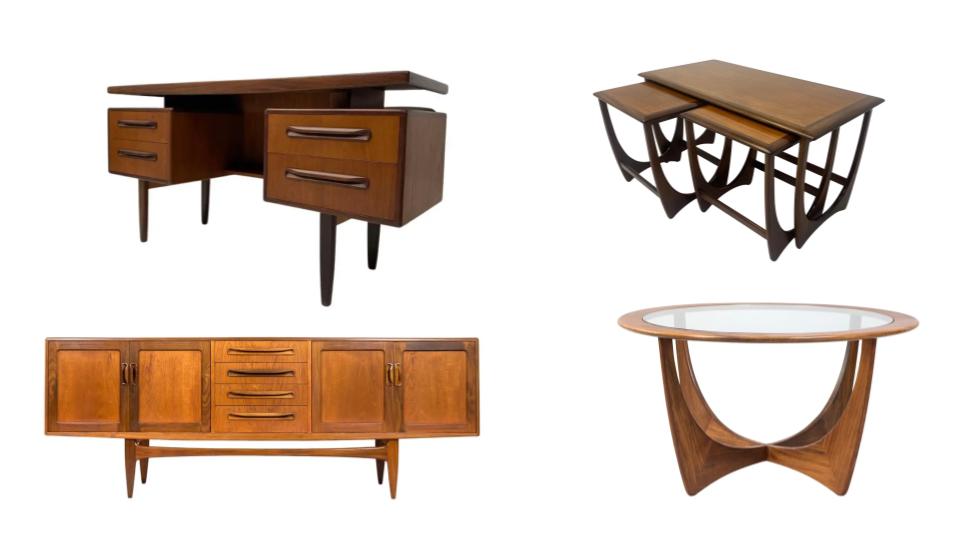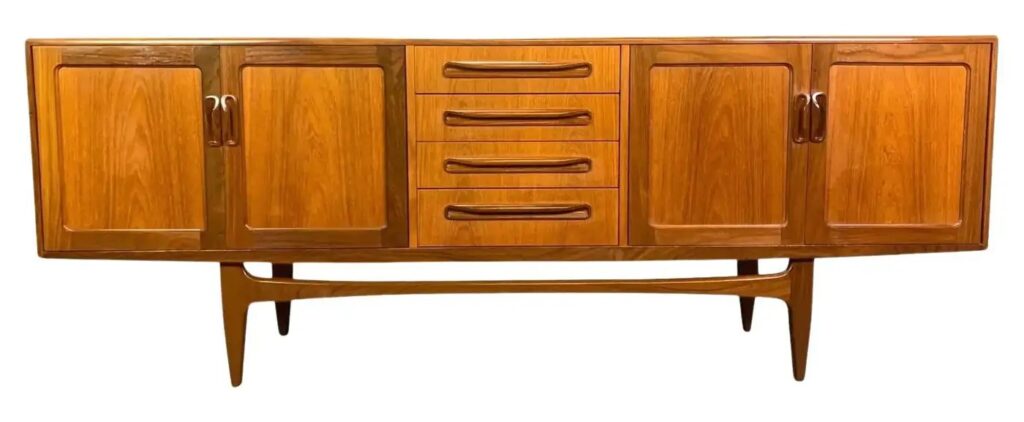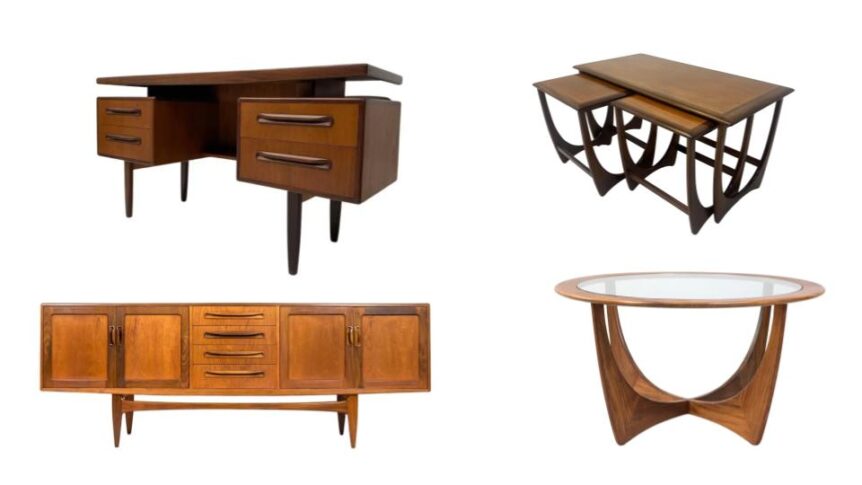The Complete Guide to Identifying Genuine Vintage G-Plan Furniture from the Mid-20th Century Modern Design Era

G-Plan furniture has a distinctive mid-century modern style that makes it highly desirable for vintage furniture lovers today. With clean lines, simple forms, and quality construction, G-Plan furniture from the 50s, 60s, and 70s has a timeless appeal.
But with many lookalikes on the market, how do you spot an authentic vintage G-Plan piece? This guide will walk you through the key features to look for so you can identify real G-Plan furniture.
The Origins of G-Plan Furniture
First, a quick history lesson. G-Plan was launched in 1953 by E Gomme, a British furniture company known for its quality cabinet making. The “G” stood for Gee, Gomme, and Company, the founders. Their idea was to create well-designed, affordable furniture using modern materials and manufacturing techniques.
G-Plan furniture was marketed as “planned furniture for planned living” and its modular, coordinated look proved extremely popular with young couples setting up their first homes in the postwar era. Throughout the 50s, 60s, and into the 70s, G-Plan was at the forefront of British contemporary furniture design.
So pieces made by Gomme under the G-Plan name during this period are considered vintage originals and are highly collectible today. By studying the distinctive traits of these mid-century designs, you can identify authentic G-Plan furniture.
How to Identify Vintage G-Plan Furniture
Below is a few tale-tale sign on how to spot authentic, vintage G-Plan furniture.
Examine the Construction Quality
Authentic vintage G-Plan furniture is always sturdily constructed from quality hardwoods like teak, mahogany, walnut and beech. Joinery is precise and clean thanks to techniques like mortise and tenon as well as dovetailing. Drawers should feature dovetailing on both the front and back rather than just the front facade.
Shelving tends to be permanently fixed rather than adjustable. Drawer glides and stops have a high-gloss finish as do the elongated metal handles. These handles range from enameled steel to brass to aluminum but consistently match the color scheme of the overall piece.
Inspect the Legs and Base
Legs on authentic G-Plan are slender and tapered, often with a telltale X-shape cross at the base. This X-base, first used on the iconic “C” series, became a signature. Legs should be made of solid wooden construction rather than hollow tubular metal.
Substantial weight and stability should be evident when moving the furniture. Wobbling or unsteadiness suggests lower-quality construction. Examine the underside for any identification stamps that can help confirm vintage origins.
Compare Proportions Against Era
G-Plan tailored its furniture dimensions to suit postwar British homes. Pieces typically have compact proportions versus oversized, expansive silhouettes. Narrow legs and arms, shallow drawer depths, and petite tabletop surfaces are period-accurate.
Substantial depth and width or chunky dimensions signify newer production. When evaluating scale, remember G-Plan made smart use of space – so avoid pieces that feel imposing or undersized for the time.
Evaluate Any Branding Marks
Authentic vintage G-Plan exhibits distinct manufacturer’s markings to look for. Expect to find a black circular stamp about 1 inch in diameter impressed into the wood itself – typically under tables or the backside of chairs.
This stamp reads “G-PLAN” in capital letters. You may also come across original rectangular paper label stickers in red and gold affixed to drawer bottoms. These branding marks confirm furniture originated directly from G-Plan factories in the 1950s-1970s.

Verify Mid-Century Design Elements
G-Plan prioritized unfussy, simple lines according to midcentury modern aesthetics. Look for unadorned surfaces devoid of excessive carvings, inlays, or ornamentation. Instead, you’ll see seamless laminated tops and unembellished cabinet fronts.
Legs form slender tapered columns without decorative feet. Pieces feel airy and light versus ponderous. Silhouettes emphasize fluid, gently curved forms across chair arms, cushion edges and drawer fronts. Wood veneer takes center stage.
Look for the Complete Package
G-Plan designed interchangeable, modular furnishings to mix and match. Authentic collections will include design unity across pieces like consistent tapered legs, matching drawer pulls or coordinated color palettes.
Whether it’s a set of end tables, a complete dinette, or a nested coffee and side table pairing, authentic G-Plan displays cohesive elements marking pieces as part of a larger vision.
Spotting genuine vintage G-Plan comes down to carefully comparing furniture traits against this era-specific checklist. Study everything from materials to hardware to dimensions before reaching conclusions. With a discerning eye and this comprehensive guide, identifying authentic midcentury G-Plan is fully achievable.
Related questions:
- How To Identify Mcintosh Of Kirkcaldy Furniture
- How To Identify Nathan Furniture
- How to Identify Ercol Furniture
- Stag Furniture Ranges – A Look at the Best of British Mid-Century Design
How to Spot a G-Plan Sideboard

The simple yet cleverly designed G-Plan sideboard was a fixture of many British dining rooms. Features to look for:
- Label or Stamp: The first step in identifying an authentic G-Plan sideboard is to look for a label or stamp. G-Plan furniture typically features a small metal label affixed to the back or underside of the piece. The label should display the iconic G-Plan logo with the letter “G” enclosed in a circle. Some older G-Plan sideboards may have a foil stamp instead of a metal label.
- Quality of Construction: G-Plan sideboards are known for their high-quality construction. Examine the piece closely for signs of fine craftsmanship, such as precise joinery and smooth surfaces. The wood used in G-Plan sideboards is often teak or afromosia, known for their durability and attractive grain patterns.
- Design Elements: G-Plan sideboards typically feature a mid-century modern design with clean lines and minimalistic aesthetics. Look for sleek, simple shapes and elegant finishes. G-Plan sideboards were designed to be functional and visually appealing, making them a versatile addition to various interior styles.
- Handles and Hardware: Pay attention to the handles and hardware on the sideboard. G-Plan sideboards often have distinctively shaped handles made of brass or teak. These handles are a hallmark of G-Plan furniture and can help authenticate the piece.
- Patina and Age: Authentic vintage G-Plan sideboards will exhibit signs of aging and patina. Look for subtle wear and tear, minor scratches, and natural discoloration that occurs over time. The patina adds character and authenticity to the piece.
Related article: 15 Best Mid-Century Sideboards (1960s-1970s)
Related articles:
- How To Value Mid-Century Modern Furniture
- How To Find Cheap Mid-Century Furniture
- 9 Best Vintage Furniture Brands
FAQ About G-Plan Furniture
When was G-Plan furniture produced?
G-Plan furniture was first manufactured in 1953 by the British company E. Gomme Ltd, which launched it as an affordable, modular style tailored to modern living. The brand remained popular throughout the 1950s and 1960s. In the early 1970s, production began tapering off as tastes changed.
By 1976, the original G-Plan line ceased production entirely. So the vintage G-Plan pieces most sought after by collectors today were made during the brand’s heyday of the 50s and 60s.
Why was it called G-Plan furniture?
The “G” in G-Plan stands for Gee, Gomme and Company. This was the name of the English furniture maker that introduced G-Plan in 1953. The three original founders were Tom Gomme, Fred Gee, and Noel Gee, so they took the initial G for their last names to create the G-Plan branding. It was marketed as sleek “planned” furniture for contemporary living, hence the full name.
What does an authentic G-Plan stamp look like?
Vintage G-Plan furniture bears a circular stamp impression measuring about 1 inch in diameter. It will be stamped into the underside of tables, chairs, and other wood pieces. Sometimes inside drawers. The stamp reads “G-PLAN” in all capital letters in a bold serif font. This branding mark confirms the pieces came directly from authorized G-Plan factories in the 1950s-70s. The stamp will be black or very dark blue.
When was G-Plan furniture most popular?
G-Plan furniture peaked in popularity from the mid-1950s through the 1960s due to its trendy modern styling and modular approach. Its affordable prices also made it accessible for young postwar couples furnishing first homes.
By the early 1970s, the clean-lined midcentury look was falling out of fashion in favor of more ornate styles. But today G-Plan is appreciated again by vintage collectors and interior designers wanting to recreate a Mad Men-era aesthetic.
What style is G-Plan furniture?
G-Plan furniture epitomizes mid-century modern style. Its hallmarks include slender tapered legs, minimalist shapes with clean lines, wooden cabinets often in teak or walnut veneer, glossy lacquered finishes in bold primaries, geometric upholstered cushions, and interchangeable modular components for flexibility. G-Plan favored unfussy, understated elegance over ornamentation.
Related questions:
- 15 Best Vintage American Furniture Brands
- How to Identify Stag Furniture: A Comprehensive Guide
- How To Identify Mid-Century Modern Furniture
Conclusion
G-Plan’s minimalist “planned” furniture look embodied mid-century modernism in Britain. By studying their furniture’s distinctive construction, branding, proportions, and styling, you can identify authentic vintage G-Plan pieces.
Just take time to carefully inspect each attribute against G-Plan’s signature design canon before confirming legitimacy. With some diligent detective work, you’ll be on your way to owning some iconic vintage furniture history.


